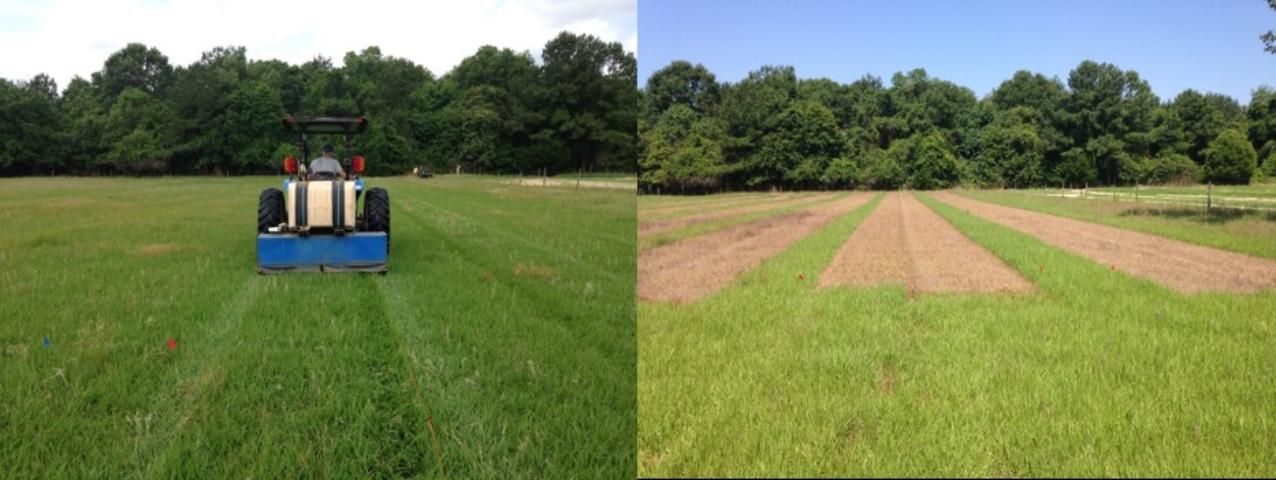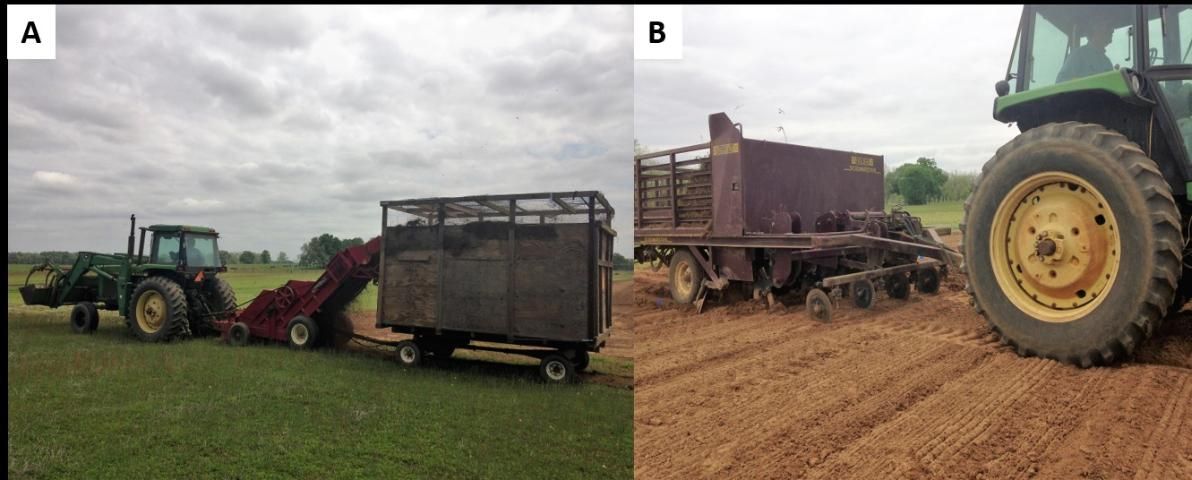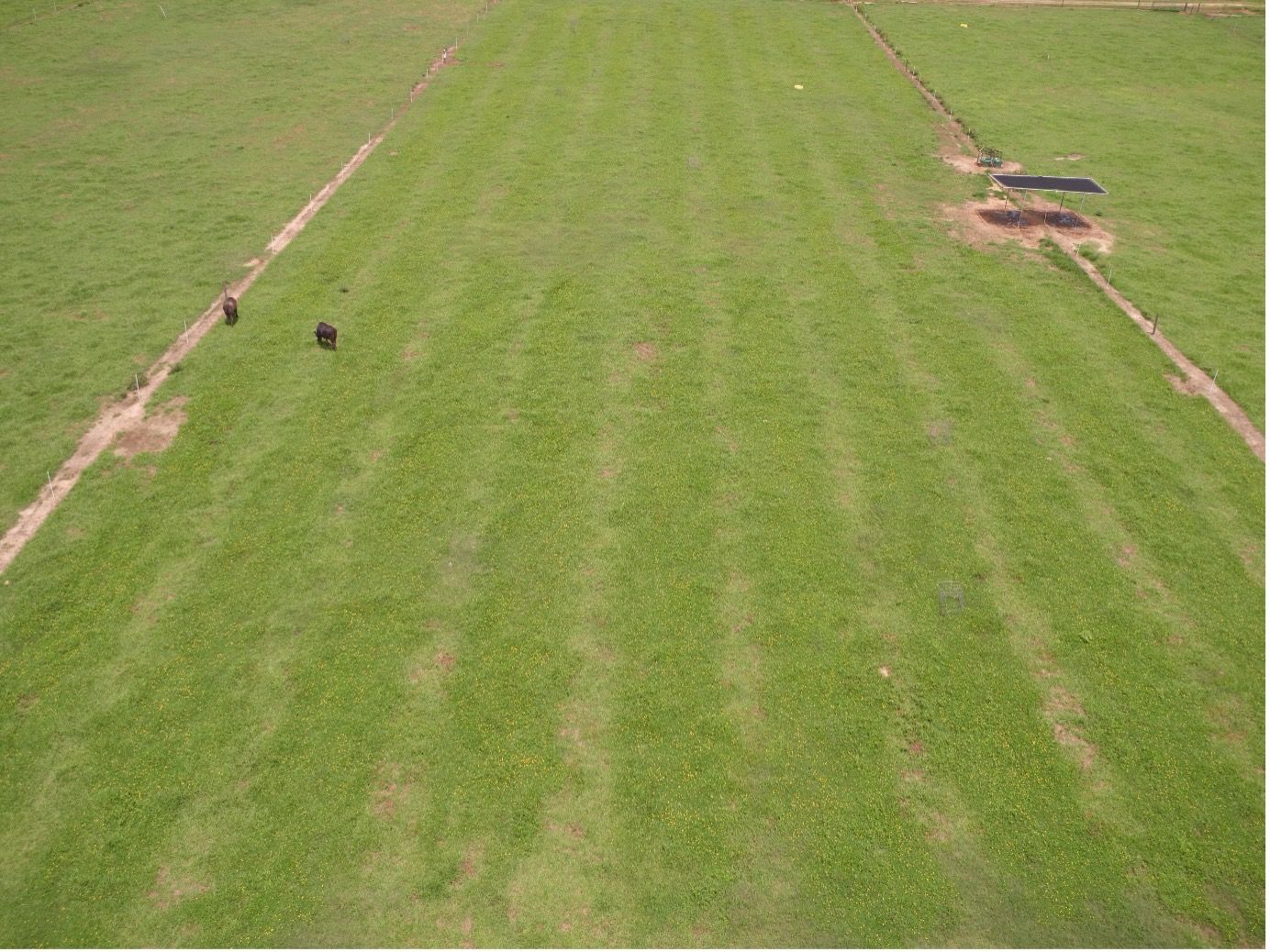Introduction
Nitrogen (N) is one of the major off-farm inputs in livestock systems, either in the form of N fertilizer or purchased feed (e.g., soybean, cottonseed meal). Fortunately, you can reduce those expenses by growing your own nitrogen using forage legumes. Rhizoma perennial peanut (RPP) is a legume adapted to the Florida environment that grows well in mixtures with bahiagrass. When grown in pure stand, RPP associates with soil bacteria and fixes up to 200 lb N/acre from atmospheric nitrogen, depending on the variety (Dubeux et al. 2017). Based on the percentage of rhizoma peanut in the pasture, the added N in mixtures would be lower. Instead, you could expect a range from 50 to 100 lb N/acre per year in well-established mixtures. Nitrogen fixed by the legume is recycled back to the soil via cattle excreta and plant litter, acting as a slow-release fertilizer. As a result, companion species in the mixtures, such as bahiagrass, can get the benefit of the fixed N. Rhizoma perennial peanut also has better nutritive value than bahiagrass. Typically, bahiagrass has digestibility ranging from 48 to 52% and crude protein from 8 to 12%. Rhizoma peanut has digestibility ranging from 68 to 72% and crude protein from 15 to 18%. This difference is large enough to result in a significant increase in cattle performance on rhizoma peanut.
Establishing a rhizoma peanut stand takes time. With a good management program (i.e., weed control and fertilization) and adequate soil moisture, RPP can be established in one year. Researchers currently recommend strip-planting RPP in order to reduce the cost of establishment and facilitate weed control. After establishment, well-managed RPP pastures are expected to last for more than 10 years. Integrated RPP-bahiagrass pastures will reduce N fertilizer inputs and enhance livestock performance, reducing production costs and minimizing environmental risks associated with N fertilization.
Varieties and Establishment
Many varieties and germplasm are available in Florida, but Florigraze and Ecoturf have been tested more extensively under grazing. Recent research has demonstrated better productivity with Ecoturf compared to Florigraze (Dubeux et al. 2017); therefore, researchers recommend Ecoturf if the RPP is to be used in a grazing system.
Rhizoma perennial peanut is vegetatively propagated, using dug rhizomes for planting material. Typically, 80 bushels of rhizomes are used to establish one acre. Rhizomes should be dug and planted within 24 hours to assure sprig viability for uniform stands. Soil moisture is critical during RPP establishment. In Florida, RPP can be planted in early spring with adequate soil moisture available. However, May is typically dry and should be avoided, unless irrigation is available. Well-drained sites are recommended for RPP establishment. Recent data indicate summer planting (June–July) is as good or better than spring planting in Florida (L. Sollenberger, personal communication). More rapid growth and more reliable rainfall are advantages of summer planting. Target soil pH is 6.0. Other nutrients should be applied according to UF/IFAS recommendations for RPP (https://edis.ifas.ufl.edu/ss163).
Strip-planting RPP can reduce establishment cost, because only 50% of the total area is planted. Matching the width of the RPP strip with the equipment width (e.g., spriggers, sprayers, haying equipment) is a practical option. At the UF/IFAS North Florida Research and Education Center in Marianna, researchers planted 9-ft wide RPP strips between 9-ft wide bahiagrass strips. If bahiagrass pastures are already established, the existing sod must be killed with glyphosate prior to planting the RPP (Figure 1). This can be done during the previous fall; if needed, glyphosate can be reapplied prior to planting in the spring. If bahiagrass and RPP are being established at the same time, it is important to make sure soil moisture is adequate, then prepare the seedbed and plant both species in early spring. Commercial sprigging services are available because of the specialized equipment needed. Equipment for planting includes a digger and sprigger (Figure 2).

Credit: Jose Dubeux, UF/IFAS

Credit: Jose Dubeux, UF/IFAS

Credit: Jose Dubeux, UF/IFAS
Weed Management
Once RPP is established, it is critical to suppress weed competition. Strip-planted RPP allows for the use of RPP-labeled herbicides while minimizing potential damage to the neighboring grass strips. Imazapic is labeled for use in RPP stands in Florida and is very effective during the establishment period (Castillo et al. 2013). Imazapic should be used as a preemergent or early postemergence herbicide. The recommended rate is 4 fl oz/acre. If grass weeds are a problem, Clethodim products can also be used according to label recommendations. Recently, Gly Star Plus, a glyphosate product, was labeled for use in established perennial peanut grown for hay in Florida. Gly Star Plus can be applied during the dormant season to control winter weeds, during the growing season as a wiper application, or even broadcast if other options are not available. Gly Star Plus will severely injure bahiagrass, so it should only be used on the RPP strips. Injury will occur when used on RPP during the growing season, but the crop should recover 40 to 60 days after application. Stands during the establishment year should not be sprayed with Gly Star Plus. The complete recommendation for weed management on RPP is available at https://edis.ifas.ufl.edu/wg216. During the first establishment year of RPP, Castillo et al. (2013) observed a positive effect of 45 lb N/acre. The N application resulted in faster groundcover and increased RPP establishment, as long as weeds were adequately controlled.
Grazing Management
Ecoturf perennial peanut is tolerant to grazing. Researchers continuously stocked pastures with variable stocking rates for three years (2015, 2016, and 2017), and the strip-planted RPP performed well (Jaramillo et al., 2021). Results from three years of grazing indicate the possibility to replace 100 lb N/acre by strip-planting RPP and maintain the productivity. Average stocking rate was lower for the bahiagrass-RPP mixtures compared to N-fertilized bahiagrass pastures; however, the average daily gain (ADG) was significantly greater for BG-RPP pastures (Table 1). These results indicate that BG-RPP pastures could also be an option for heifer development grazing systems, especially in combination with overseeded cool-season forages.
Cost-Share Program
NRCS established a cost-share program to strip-plant rhizoma peanut on bahiagrass pastures. For more information, contact your NRCS representative in your county.
Conclusion
Integrating rhizoma perennial peanut into grazing systems can reduce nitrogen fertilization requirements and feed supplementation during the warm season. Strip-planting is a viable option to reduce rhizoma peanut establishment cost compared to an RPP monoculture. Additionally, strip-planting helps to facilitate weed management, compared to sprigging into a living grass stand. In this study, overseeding warm-season grass-legume pastures with a blend of cool-season grass-legume mixtures extended the grazing season and resulted in livestock performance equivalent to that of N-fertilized grass systems. Minimizing N fertilizer inputs reduces not only ranch production costs, but also some of the environmental problems related to the use of N fertilizers.

Credit: Jose Dubeux, UF/IFAS

Credit: José Dubeux, UF/IFAS
References
Castillo, M. S., L. E. Sollenberger, J. A. Ferrell, A. R. Blount, M. J. Williams, and C. L. Mackowiak. 2013. "Strategies to control competition to strip-planted legume in a warm-season grass pasture." Crop Science 53: 2255–2263.
Dubeux, J. C. B., Jr., A. R. S. Blount, C. Mackowiak, E. R. S. Santos, J. D. Pereira Neto, U. Riveros, L. Garcia, D. M. Jaramillo, and M. Ruiz-Moreno. 2017. "Biological N2 fixation, belowground responses, and forage potential of rhizoma peanut cultivars." Crop Science 57: 1027–1038.
Jaramillo, D.M., J.C.B. Dubeux, Jr., L.E. Sollenberger, J.M.B. Vendramini, C. Mackowiak, N. DiLorenzo, L. Garcia, L.M.D. Queiroz, E.R.S. Santos, B.G.C. Homem, F. van Cleef, M. Ruiz-Moreno. 2021. Water footprint, herbage, and livestock responses for nitrogen-fertilized grass and grass-legume grazing systems. Crop Sci. 61:3844–3858.